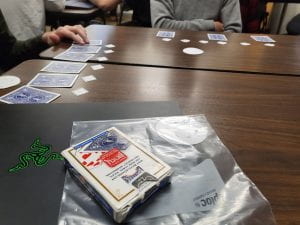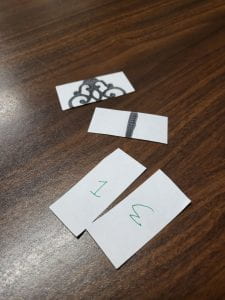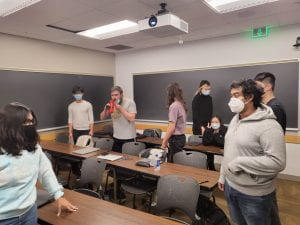Pieces: 4 circle with the numbers 1, 4, 2, 8, 5, 7 printed on them in a clockwise sequence, cards (regular playing cards), 4 sets of labels (numbers 1-6 each in a cutout of the 4 suits in cards)
Players: 4
Mechanics: Only Ace, 2, 4, 5, 7, 8 cards are used in this game. All cards played or swapped will be face down so no one can see the card. Shuffle the cards, then deal 6 to each player. Each player needs to put their labels down in front of them in order. They can play 1 card each turn in any position in their own spots, or swap two cards in any positions (their own cards as well). They are not allowed to look at the card before a swap, but they can look at it once the swap is complete. If the player is swapping with another player, both players can look at the cards, but only after the swap. To win, the player needs to have a combination of any of the cyclic numbers in their slots (142857, 285714, 428571, 571428, 714285, 857142), which would be presented to them in the circle. Once a player thinks they have the winning combination, they can flip their cards over to show everyone. If they do, they win. If they don’t, the player can flip their cards back, but they would be at a massive disadvantage.
I’ve always felt I have a certain vicinity with numbers. Finding patterns in things, especially number related, has always been very intriguing to me, perhaps one of the reasons I like puzzles so much. There are a lot of numbers that demonstrate very cool patterns, and we see them all the time, but we do not really use or care about the patterns. One of these patterns is cyclic numbers, particularly 1/7. It is the only cyclic number in decimal, and we use it decently frequently because 7 is not an uncommon number. 1/7 = 0.142857 repeat, and these exact digits are repeating in all its whole number multiples, except the starting digit of the sequence is different. I’ve been talking to some old friends and new friends recently about their recent experiences, and I keep observing a same sort of pattern in their experiences as well. We came to a conclusion of sort that some things will keep changing, but as long as a core part of things stay the same, some elements will also stay the same. During quarantine and the spread of COVID, most of us have to stay in at different times, and we are all dealing with different issues that contact with each other just slowly fades away. Some of my old friends that are in college choose to study abroad or go on a mission with their church, and their communications would be even more limited. Some of my friends who are not yet in college but will be very soon fears that they might lose their old friends. But all in all, if we all try to remain in contact with each other, and our feelings are neutral, we can always be friends and support each other in our own ways. I think some of the game pieces that we learned about earlier in the semester could definitely convert similar feelings into a mechanics that can express such a feeling of everything changing but nothing changing as well. The scores we learned about, especially some of the Yuki Ono pieces that use extremely simple mechanics, and white chess, a game where it is extremely difficult to play because of the change of mechanics came to mind. I also wanted to feature things people have access to fairly easily in their lives in the mechanics, because this feeling is not something rare, but rather something that just comes up once in a while when I am alone or talking to someone I am close to. Therefore I chose to use cards, and their suits to represent the players. I really enjoy the suits of the cards because they are easily accessible, and trying to create a combination of the number with different suits and different colors can make the player feel the change more than just all cards in the same color. I wanted randomness in the game as well because I think a certain degree of randomness is very fun, and life is filled with surprises. In the end I think the game ended up at a good place, and the playtests went pretty well, and players even came up with different play styles.











